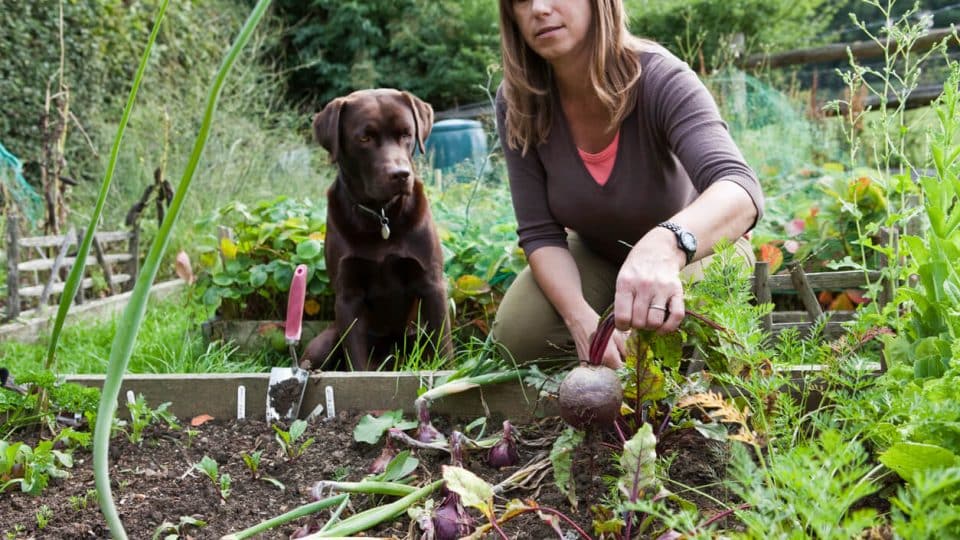Beets can be a healthy and nutritious addition to human diets, adding flavor and color to salads, soups … and cakes! And yes, dogs can eat beets too. While you shouldn’t feed your dog whole beets every day, these root vegetables are safe for dogs to eat in moderation.
Beets are a healthy source of vitamin C, fiber, folate, manganese, and potassium. Since these vitamins and minerals are good for your dog’s digestion, immune system, skin, and coat, you’ll find them as an ingredient in dog food, such as high-fiber kibble.
However, not every part of the beet is safe. Read on to learn more about how beets can impact your dog’s diet and ways to add them to their bowl.
Types of Beets & Their Edible Parts
“Dogs can safely eat most types of beets,” says Dr. Dwight Alleyne, DVM, a veterinarian at JustAnswer. Beets come in many varieties and colors and, according to Dr. Alleyne, red beets are the most common variety fed to dogs. Dogs can eat raw, boiled, or steamed, and it’s best to feed them beets without the skin.
While the root is safe for your dog to eat, don’t feed your dog the tops, also known as the leaves, of beets. “These contain oxalates which can contribute to the formation of bladder or kidney stones,” says Dr. Alleyne.
You should also avoid letting your dog get into beets that are pickled, canned, or seasoned. “These aren’t generally suitable for dogs due to their high sodium content and other additives,” says Jessica Jova, LVT (Licensed Veterinary Technician) at Bahama Road Veterinary Hospital.
Side Effects of Too Many Beets
If you want to feed your dog beets, stick to occasional, small servings. If your dog gets into a bag of beets, they may experience some stomach upset. However, if your dog is a chronic beet thief, there can be long-term health issues due to increased carbohydrate and sugar intake.
“Feeding too many beets could cause digestive issues, leading to weight gain, and increase the tendency for diabetes,” says Dr. Alleyne.
You may also put the beets away if your dog is on a veterinary-prescribed diet. “Beets in any quantity may be contraindicated,” Jova adds, suggesting that the prescribed diet may not work as intended.
Ways to Eat Beets: Serving Size & Method
If you’re looking to feed your dog beets, Jova recommends that they should be an occasional treat and not an everyday part of your dog’s diet. In terms of serving size, dogs should not consume more than 1 to 2 teaspoons of beets per 15 pounds of body weight a couple of times a week.
Ways dogs can eat beets include:
- Cooked and mashed for easier digestion
- Shredded or grated as a topper to avoid choking
- Added to homemade treats like our Red Velvet Pupcakes
And as with any new food, Dr. Alleyne recommends consulting with your veterinarian. “If you plan to feed your pet beets on a long-term basis, you can discuss the need for any diagnostics to rule out any medical conditions.”
Should I Be Worried If My Dog’s Poop and Pee Is Red?
Will beets change the color of your dog’s poop or pee? Maybe, but it’s nothing to be concerned about. “Due to a pigment in beets called betanin, it is possible to change the color of a dog’s feces, but this is not likely to affect the color of the urine,” explains Dr Alleyne.
Beets as a Treat, Not a Meal
Beets are generally safe for dogs in moderation. They offer health benefits like fiber and vitamins but come with some risks, including their high sugar content. Never feed your dog the green tops of beets, as these contain oxalates, which can cause health issues.
Make sure you prepare beets properly for your dog and only feed small portions as an occasional treat. As with any new food, introduce beets to your dog’s diet slowly, and monitor them for any digestive issues. If you’re concerned, it’s always best to speak to your veterinarian for advice.
Other vegetables dogs can eat
In addition to beets, there are plenty of other vegetables for your dog to enjoy. Offer them a variety, and you might find they have a firm favorite!
Some options to try include:



